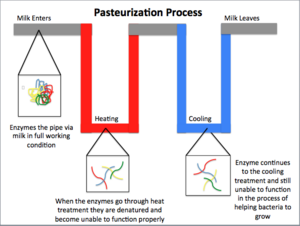
Back Pasteurisasie AF بسترة Arabic Pasteurización AST Pasterizə AZ Пастеризация BA Пастэрызацыя BE Пастэрызацыя BE-X-OLD Пастьоризация Bulgarian পাস্তুরায়ন Bengali/Bangla Pasteurekaat BR

Pasteurization (or pasteurisation) is a process of heat processing a liquid or a food to kill pathogenic bacteria to make the food safe to eat and to preserve longer. It involves heating the food to kill most harmful microorganisms. Producers pasteurize dairy and other foods to make them safe to eat. The process is named after Louis Pasteur. He was the first person to learn how to do it successfully. The first pasteurization was done by Louis Pasteur and Claude Bernard on 20 April 1862.
Unlike sterilization, pasteurization is not intended to kill all microorganisms in the food. Instead, pasteurization gets a "log reduction" in the number of microorganisms. It brings their number down so they are unlikely to cause disease if the product is kept in the refrigerator and consumed before its sell-by date. Commercial sterilization of food is not common, because it tends to destroy the flavour of the food.